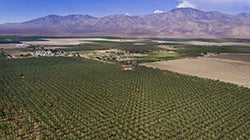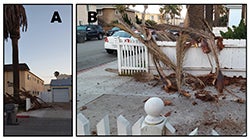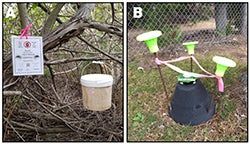
The South American Palm Weevil Invasion in San Diego County, California
The Situation: The South American palm weevil (SAPW), Rhynchophorus palmarum, is a non-native pest of palms that has established populations in San Diego County in California. In December 2010, this weevil was discovered infesting ornamental Canary Islands date palms (CIDP) (Phoenix canariensis) in Tijuana, Baja California, Mexico.California Department of Food and Agriculture trapping programs detected SAPW in San Ysidro (~5 miles north of Tijuana) in San Diego County in 2011. Around 2014 reports of CIDP dying from SAPW attack were confirmed in San Ysidro. It is likely that SAPW established populations in San Diego County around 2014, or perhaps earlier than this date. Weevils have also been detected in Alamo Texas in 2012 and Yuma Arizona in 2015. SAPW has not established in Texas or Arizona.

What Does the Weevil Look Like? Adult weevils are large, black in color, and about 1.5 inches in length. The adult weevils have wings and are strong fliers. Weevil larvae are whitish in color and can grow up to five inches in length. Weevil larvae pupate inside fibrous cocoons that may be found in the infested crown region or in tunnels weevil larvae drill into the base of palm fronds. Adult weevils emerge from cocoons when pupation is complete.

Where is the Weevil?Tijuana (Mexico), San Ysidro, Imperial Beach, National City, Bonita, Chula Vista, El Cajon, and San Diego City (all in San Diego County) are infested to varying degrees with SAPW. The exact area of infestation in San Diego County is not known. We are relying on community scientists and concerned citizens to report palms that are suspected of having been killed by SAPW. To report an infested palm or one killed by SAPW an online form can be completed and submitted. Click here to report an infested palm.
A concern is that SAPW may invade the Coachella Valley and once established it could become a significant management issue for growers of edible dates, an industry with an annual value of around $68 million (US).

What Species of Palms Does the Weevil Attack? In San Diego County, the weevil has shown a very strong preference for attacking CIDP to the almost complete exclusion of other palm species at this time. Attacks on other species of palms may occur when CIDP become less common. SAPW has been documented infesting and killing açaí palm (Euterpe oleracea), African oil palm (Elaeis guineensis), Canary Islands date palm (Phoenix canariensis), coco de palmito (Euterpe edulis), coconut (Cocos nucifera), edible date palm (Phoenix dactylifera), and sago palm (Metroxylon sagu).
How Does the Weevil Kill Palms? Infestations of weevil larvae in the crown of the palm can result in death if the infestation is not treated with insecticides. The apical meristem or “palm heart” produces new fronds and extensive feeding damage to this area can kill the palm as it is unable to continue growing. Once the palm heart is heavily damaged, the crown may tilt, appears collapsed, and in some instances the crown may become detached from the trunk and drop to the ground. Advanced stages of damage results in the palm trunk being ringed by a halo of fronds.

Infested palms present a significant dropping hazard to people, cars, and property. In addition to the risk of crown drop, dead fronds readily fall from SAPW infested palms. Wind and rain events can increase the probability of frond dropping. Palm fronds are heavy and in the case of CIDP fronds, the base has large strong spines that can cause injuries.
Identification of Potentially Infested Palms: Palms in the very early stages of weevil attack are hard to diagnose as infested because weevils are hidden in the crown and can be very hard to find. As the infestation progresses visible symptoms may become apparent. Evidence of SAPW attack can be found in the crown and some of the easiest and earliest symptoms to observe are damage to fronds that are emerging from the center of the crown. Weevil feeding damage to immature fronds becomes apparent as the fronds grow up out of the center of the palm and the leaflets as they expand appear to be “clipped,” “notched,” or “windowed.”

Protecting Palms from Weevil Infestations: The best control option for protecting palms from SAPW are systemic insecticides that are either applied to the soil, trunk, or crown. These products move into the palm and accumulate in the apical meristem, the palm heart, where weevil feeding is concentrated. These products then poison weevil larvae and adults. Palms can be “cured” of moderate to heavy weevil infestations with applications of systemic insecticides. But applications need to be made before irreversible damage to the crown has occurred. In some instances all of the fronds will need to be removed, the crown thoroughly drenched, and then gradually over time, the damaged meristematic tissue will recover and new palm fronds will begin to develop. Once these pesticide programs begin they will need to continue indefinitely to protect palms from weevil attack.

What is Being Done in San Diego County?: The response to the establishment and spread of SAPW in San Diego County is following several different avenues. First, weevil population cycles over the course of a year are being monitored. Results so far suggest that weevils are flying all year round and don’t seem to stop over the winter. Second, more than 470 CIDP in urban areas are being monitored every six months for SAPW caused mortality. Over a two year period about 25% of palms monitored in urban areas have been killed by SAPW. Trials testing two different types of traps (bucket vs. Picusan) and types of fermenting bait with weevil aggregation pheromone are being evaluated. Insecticide trials evaluating different types of systemic pesticides for protecting palms from weevil attack have been set up with cooperators in several areas in San Diego County where weevil activity is high. These trials will likely run for two or more years until results become available. Finally, drones are being used to monitor palm mortality in riparian areas where foot access is difficult. Results of aerial monitoring of more than 760 palms indicate that over a 2 year period 28% have been killed by SAPW.



Drone surveillance of Canary Islands date palms killed by SAPW in the Sweetwater Reserve, Bonita California